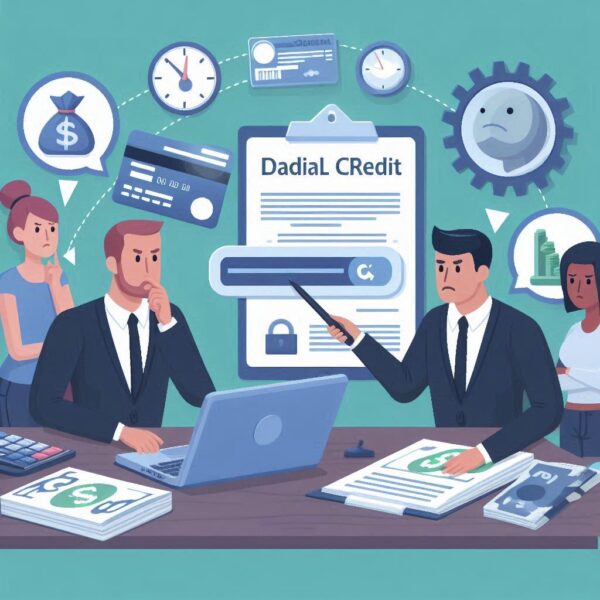Bad credit is like that annoying reminder you can’t ignore. It usually happens when you miss payments or max out credit cards. Your credit score, which typically follows you everywhere – like your shadow at noon, takes a hit. When it’s low, you’re in the ‘bad credit’ zone.
Having bad credit can affect everyday life more than you might think. It’s not just about facing loan denials or higher interest rates; it can impact things like renting an apartment, buying a car, or sometimes even getting a job. Landlords and employers might check that credit score, and you don’t want it to keep throwing roadblocks your way.
Budgeting becomes a real toughie with bad credit hanging around. Every financial decision feels like you’re walking through an obstacle course. Setting up a sensible budget helps, but it’s essential to understand the financial limitations bad credit imposes on you. Recognizing these limitations is the first thing to begin turning things around.
“Disclosure: Some of the links in this post are affiliate links. This means if you click on the link and purchase the item, I may receive an affiliate commission at no extra cost to you. I only recommend products and services I personally use and believe will add value to my readers.”
Contents
- 1 Essential Budgeting Principles for People with Bad Credit
- 2 The 50/30/20 Rule Explained in the Context of Bad Credit
- 3 Coinscaddy
- 4 Practical Budgeting Framework: The 50/30/20 Rule for Low Credit Scores
- 5 Practical Budgeting Tips and Tools for Improving Credit
- 6 Building Financial Resilience: Long-term Strategies Beyond Budgeting
Essential Budgeting Principles for People with Bad Credit
Budgeting might seem daunting, especially when bad credit feels like a heavy weight. However, understanding the core principles can really help you get a handle on things.
Start with the basics. Know what’s coming in and going out. It’s all about setting realistic goals that match your current situation. List your income sources and expenses. Prioritize essential expenses like food, housing, and utilities. This gives you a clear picture and helps you stay grounded.
Creating realistic financial goals is crucial. Dream big, but plan small steps. Whether it’s paying down debt or increasing your savings by even a little, having clear, achievable targets is motivating and can make the journey a bit smoother.
Prioritizing expenses is key when you’re working with limited funds. Focus on needs over wants. This doesn’t mean you have to remove all fun from your budget, but being strategic about your spending can keep things manageable. Cut down on non-essentials wherever possible, and find a balance that lets you still enjoy life while improving your credit.
Remember, budgeting isn’t a one-size-fits-all kind of thing. It’s about finding what works for you. Tweak and adjust your plan as you learn more about your spending habits and financial needs. This way, budgeting becomes a personal tool to help manage and eventually improve your financial situation.
The 50/30/20 Rule Explained in the Context of Bad Credit
You might’ve heard of the 50/30/20 rule, even sounds a bit like financial jargon, but it’s really straightforward and incredibly handy for budgeting.
Here’s the breakdown: 50% of your income goes to needs (think rent, food, insurance), 30% to wants (those non-essential but nice things like streaming services or dining out), and 20% to savings or paying off debts.

When you’re dealing with bad credit, this rule can still apply, but with a twist. You may need to adjust the percentages to suit your circumstances better. For example, you could shift more of that ‘wants’ percentage to pay off high-interest debt faster, or boost your emergency fund. Flexibility is your friend here.
Let’s look at it in action: Suppose you earn $2,000 a month after taxes. Ideally, $1,000 goes to needs, $600 to wants, and $400 to savings or debt. But if bad credit is on your back, maybe you make that $1,400 for needs and debt repayment, while trimming wants to $200. Adjust these compartments while you work on getting that credit score up.
Using this method doesn’t just help manage what you have; it forces you to confront spending habits and make tough but necessary choices. The aim is to build a financial strategy that works best amidst challenging credit circumstances.
Coinscaddy
Practical Budgeting Framework: The 50/30/20 Rule for Low Credit Scores
Managing finances while dealing with bad credit can be overwhelming, but the 50/30/20 budgeting method provides a simple and effective way to regain control. This rule divides your after-tax income into three categories: Needs (50%), Wants (30%), and Savings (20%). Here’s how to adapt it for your situation and use it to build a better financial future.
50% Needs: Essential Expenses & Debt Repayment
The first half of your income should cover your basic necessities. For those with bad credit, this includes rent or mortgage, utilities, groceries, and transportation—but it’s crucial to also prioritize debt repayment, especially for high-interest debts like credit cards.
Tips for Managing Needs:
- Prioritize High-Interest Debts: Focus on paying off debts with the highest interest rates first, as these cost you the most over time.
- Renegotiate Bills: Contact service providers to negotiate lower utility, phone, or internet bills. Many companies offer hardship plans or discounts for customers in tough situations.
- Explore Assistance Programs: Research local or government assistance programs for housing, utilities, or groceries to ease some of these expenses.
Example:
If your monthly income is $2,000, allocate $1,000 for essentials. This might look like:
- Rent: $700
- Utilities: $100
- Groceries: $150
- Debt Payments: $50
30% Wants: Controlled Spending on Non-Essentials
While it’s important to cut back on discretionary spending, you don’t need to eliminate all the things that bring you joy. The key is to be mindful and intentional.
Tips for Managing Wants:
- Prioritize Low-Cost Pleasures: Find affordable ways to enjoy yourself, like movie nights at home, free community events, or cooking a nice meal instead of dining out.
- Set Limits: Use a prepaid card or separate account for your “wants” budget to avoid overspending.
- Use Discounts & Cashback Apps: Leverage apps and coupons to save on non-essential purchases like dining or shopping.
Example:
With a $2,000 income, allocate $600 for wants. A breakdown might be:
- Streaming services: $30
- Dining out or treats: $100
- Hobby supplies: $50
- Savings rollover: $420 (unused wants budget can be saved).
20% Savings: Building an Emergency Fund & Improving Credit
The final 20% of your income should go toward savings, starting with an emergency fund. Having even a small cushion can prevent you from relying on high-interest payday loans or credit cards when unexpected expenses arise.
Tips for Building Savings:
- Automate Savings: Set up an automatic transfer to a savings account every payday, even if it’s just $10 or $20.
- Start Small, Aim Big: Begin with a goal of $500 for emergencies, then gradually aim for 3-6 months’ worth of expenses.
- Use Savings to Pay Down Debt: Once your emergency fund is established, redirect part of this category to reduce debt further, which improves your credit score.
Example:
From a $2,000 income, allocate $400 for savings. Consider splitting it as:
- Emergency Fund: $300
- Long-Term Savings: $50
- Credit-Improving Debt Payments: $50
Make It Easy with a Budget Template or Calculator
To help readers take action, downloadable 50/30/20 budget template. This tool allows users to:
- Input their monthly income.
- Automatically calculate allocations for Needs, Wants, and Savings.
- Track their actual expenses against the budget.
Download Now: Click here to get your free 50/30/20 Budget Template
By following this adapted 50/30/20 rule, you can make steady progress toward improving your financial health—even with bad credit. The structure provides clarity, while the flexibility allows you to tackle debt, save for the future, and enjoy life responsibly.
Practical Budgeting Tips and Tools for Improving Credit
It’s all about keeping track of those dollars and cents. Using budgeting apps can be a game-changer. They provide an easy way to monitor income and expenses, offering insights that might surprise you. Apps like Mint or YNAB show where your money’s going before it’s gone.
Creating a debt repayment plan is essential! List all your debts, from credit cards to student loans, and focus on knocking out the one with the highest interest first. Known as the avalanche method, it saves money on interest in the long run. Alternatively, the snowball method – paying off the smallest debts first – can keep motivation up with quick wins.
Finding ways to increase your income can significantly help tackle bad credit. Consider picking up a side gig or turning your hobbies into cash. Even small, consistent additional earnings can make a big difference in paying down debt or beefing up your savings.
Looking at where you can trim unnecessary expenses also adds up. Cancel subscriptions you forgot you had or cook at home more often. Small cuts across different areas can collectively lead to a healthier financial situation.
The road to better credit isn’t sprint, it’s a marathon. But with the right strategies and tools, each step will take you closer to reaching a more stable financial future.
Building Financial Resilience: Long-term Strategies Beyond Budgeting
Credit counseling and financial education can be your best allies. Seeking guidance from experts helps you see things from a different perspective and understand strategies for rebuilding credit in a sustainable way. Explore community resources or nonprofit organizations that offer free or affordable credit counseling.
Fundamentals like building an emergency fund might sound daunting when struggling with credit issues, but starting small counts. Even $10 a week adds up over time, creating a cushion for unexpected expenses that don’t force you to rely on credit cards or loans.
Healthy habits aren’t just for staying fit. Apply them to finances too. Regularly review your credit report to catch errors or identify unusual activity. Set reminders for bill payments to avoid late fees, and most importantly, keep your credit utilization low by paying down balances whenever possible.
Long-term improvement requires patience and consistency. Every small positive change in financial behavior moves you closer to better credit and stronger financial health. It’s about aiming for resilience, not perfection, and creating a steady path toward financial freedom.


Improving my credit score has been a journey, so this article really resonates with me! A while back, I struggled with high credit card balances, which took a toll on my score. After learning more about credit utilization and paying off revolving debts, I saw a gradual improvement. Checking my credit report for errors was also an eye-opener; I found a couple of outdated records that, once corrected, gave my score a decent boost. The advice on negotiating with creditors is spot on too—sometimes just having a conversation can make a difference! This article captures all those crucial strategies, and I can confirm from experience that they truly work if you stay consistent.
I appreciate you sharing your experience! It’s motivating to see how managing your credit utilization and identifying errors has positively affected your situation. Your story highlights the benefits of being proactive and determined, and I’m pleased that these tips were helpful for you. Consistency is essential—keep up the excellent work!